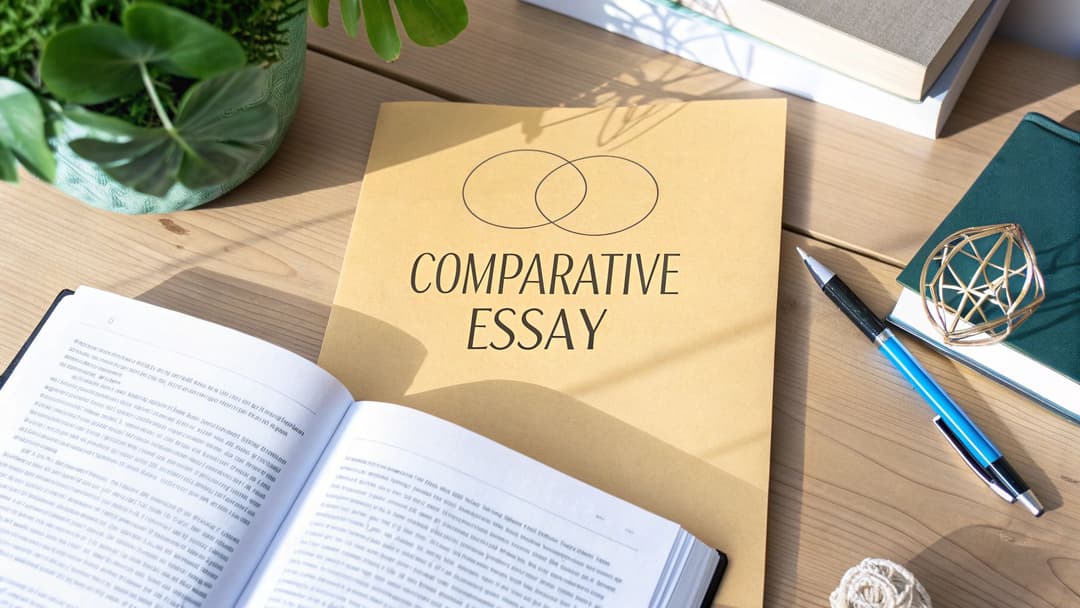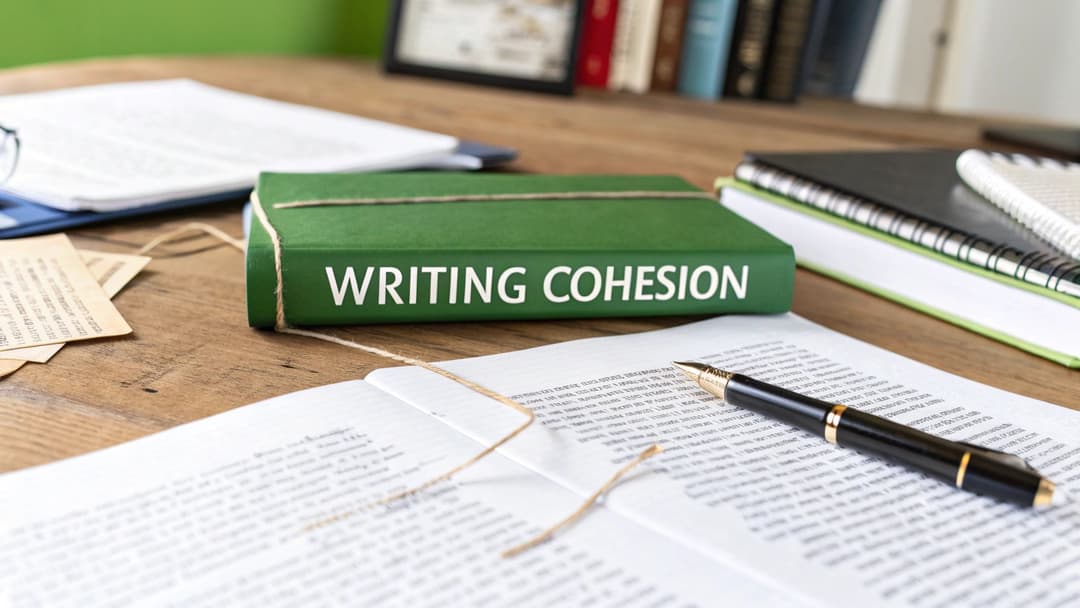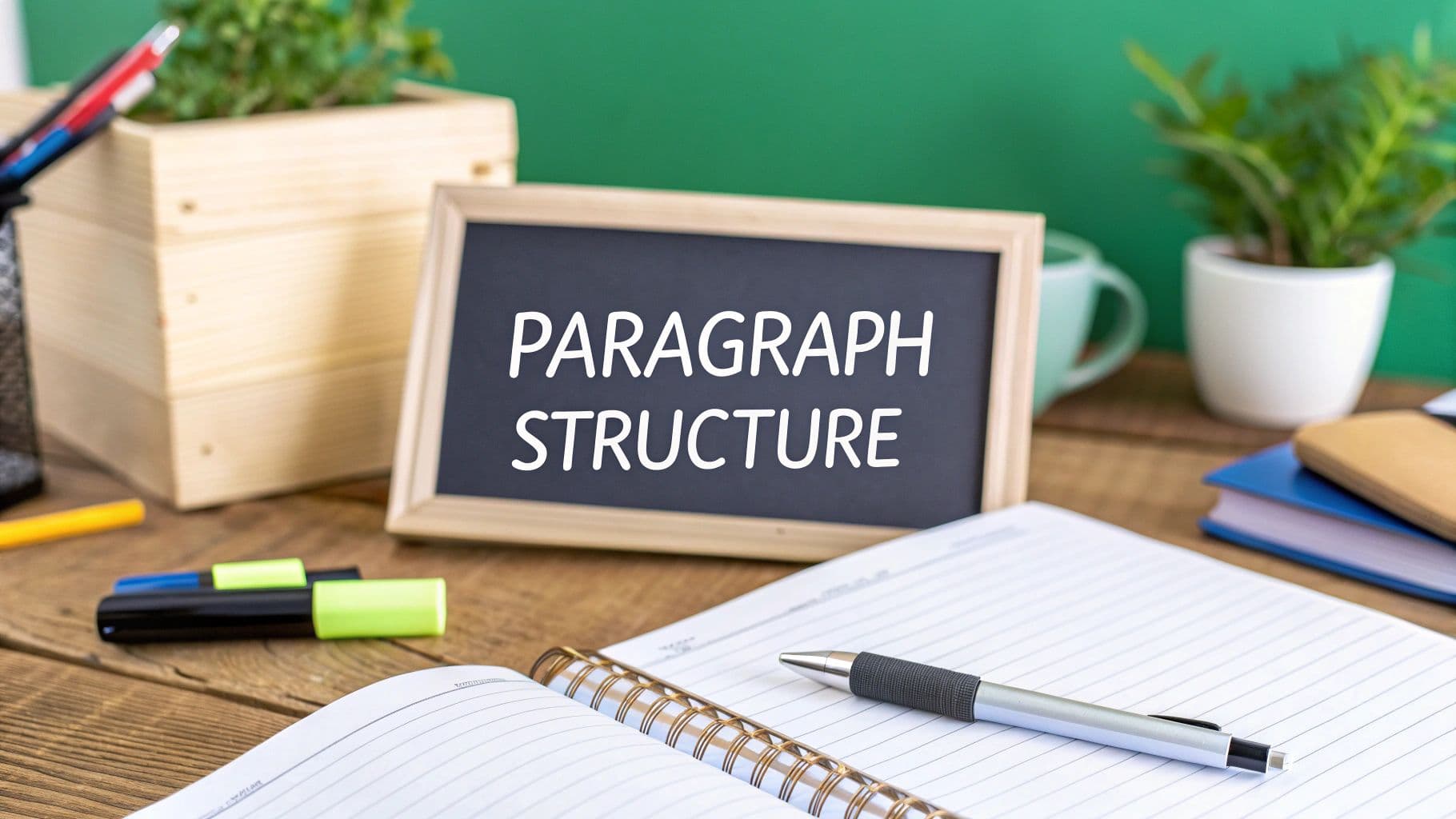
what is paragraph structure: a guide to clear writing
November 25, 2025
Paragraph structure is just the formal term for how you arrange sentences to explore a single idea. Think of it as a mini-container for one thought. You start with a topic sentence to introduce the point, back it up with a few supporting sentences, and then wrap it all up with a concluding sentence.
When you get this right, jumbled thoughts become a clear, persuasive message.
Why Paragraph Structure Is Your Secret Weapon
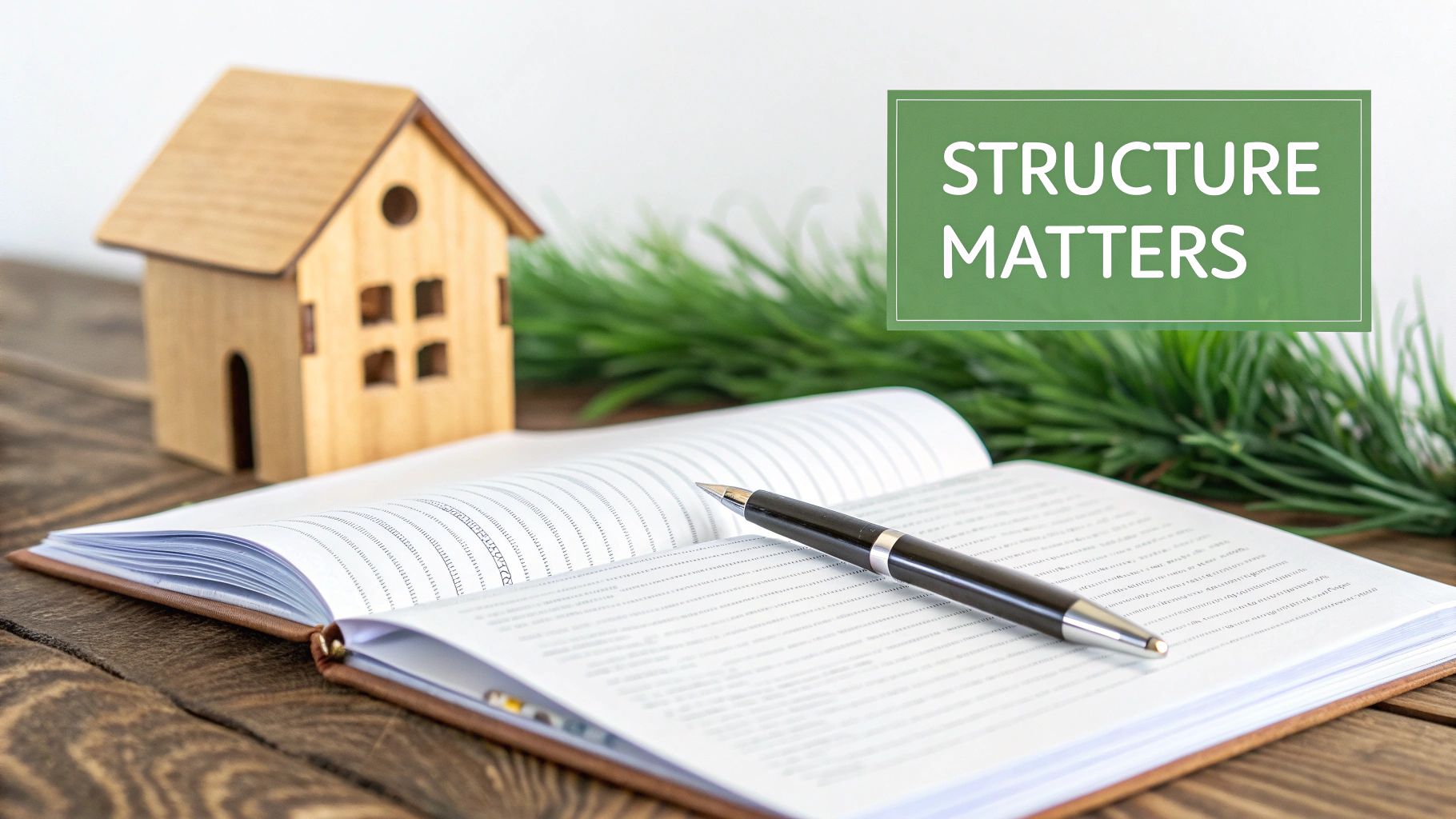
Imagine trying to build a house without a blueprint. You might have great materials—solid bricks, sturdy beams, nice windows—but without a plan, you’d end up with a mess. It wouldn’t be stable, and it certainly wouldn't be livable.
Writing works the same way. Paragraph structure is the blueprint that organizes your ideas into something coherent and strong. Each paragraph becomes a small, self-contained argument, guiding your reader from one point to the next. This isn't just about looking neat on the page; it's about making sure your message actually lands.
The Power of a Clear Framework
A solid paragraph structure is non-negotiable for anyone who writes for a living, from academic writers to content marketers. It's the difference between being heard and being truly understood.
The benefits are pretty immediate:
- Boosts Clarity: It forces you to stick to one idea at a time, so you don't overwhelm or confuse your reader.
- Increases Persuasion: A logical flow makes your arguments feel more credible and convincing.
- Improves Engagement: People stick around when content is easy to follow. Simple as that.
This isn't some new-age writing hack. It’s a foundational skill. In fact, research shows that around 85% of universities now teach this traditional paragraph model as a core writing competency. And it's no surprise—students who nail this framework consistently get better grades.
A paragraph is a self-contained unit of discourse in writing dealing with a particular point or idea. A paragraph consists of one or more sentences.
To give you a quick cheat sheet, here’s a breakdown of how the different sentence types work together.
The Core Components of a Paragraph
| Component | Primary Role |
|---|---|
| Topic Sentence | States the single main idea or claim of the paragraph. It's your signpost. |
| Supporting Sentences | Provide evidence, examples, data, or explanations to back up the topic sentence. |
| Concluding/Transition Sentence | Summarizes the main point or smoothly bridges the gap to the next paragraph's idea. |
Each part has a job to do, and when they all work together, the whole paragraph is stronger for it.
Of course, maintaining this kind of consistency goes beyond just one paragraph. If you're managing content for a team, creating a style guide is a great way to ensure everyone stays on the same page with structure and writing standards.
The Three Building Blocks of a Perfect Paragraph
Think of a paragraph as a self-contained unit of thought—a mini-essay, really. It needs a clear beginning, a solid middle, and a clean end. Each part has a job to do, and when they work together, they build a powerful, convincing point. Getting these three building blocks right is the first step to writing with clarity and impact.
These parts aren't just arbitrary rules teachers came up with. They’re the framework that makes your ideas easy for a reader to follow. If you skip one, it’s like trying to build a stool with only two legs. It’s just not going to stand up.
The three essential parts are the Topic Sentence, the Supporting Sentences, and the Concluding or Transition Sentence.
The Topic Sentence: The Paragraph's North Star
Your topic sentence is the most important sentence in the entire paragraph. It’s a signpost at the very beginning that tells your reader exactly what idea you’re about to explore. No guesswork.
A strong topic sentence gives your reader a quick preview of what’s coming, setting their expectations and keeping the paragraph focused. It’s basically the thesis statement for your mini-essay—specific, concise, and right up front.
This idea became a staple of writing instruction in the mid-20th century, as universities worked to standardize how students constructed essays. Today, the topic sentence is still considered the foundation in 89% of academic writing guides, which shows you just how critical it is.
A well-crafted topic sentence also keeps you on track, preventing you from wandering off-topic. For a deeper dive, check out our guide on how to write effective topic sentences for body paragraphs.
Supporting Sentences: The Evidence and Explanation
Okay, so you’ve stated your main idea. Now you have to back it up. That's where supporting sentences come in. They make up the body of your paragraph and deliver the evidence, examples, and explanations your reader needs to be convinced.
Without them, your topic sentence is just an empty claim. This is where you build your case.
Every supporting sentence should connect directly back to your topic sentence, adding specific details that expand on it. Think of yourself as a lawyer in a courtroom: the topic sentence is your opening statement, and the supporting sentences are all the evidence you lay out for the jury.
Key Takeaway: Strong supporting sentences do more than just rephrase the main idea. They add depth and credibility with new information, analysis, or examples that make your point feel real and believable.
The Concluding or Transition Sentence: The Graceful Exit
The final sentence of a paragraph can do one of two jobs. A concluding sentence neatly wraps up the main idea, often by restating the key point or offering a final thought. This gives the reader a nice sense of closure and works well for standalone paragraphs or the very last paragraph of a piece.
More often, though, you’ll use a transition sentence. This is a much smoother move. A transition sentence doesn't just summarize the point you just made; it also builds a bridge to the idea in the next paragraph.
This creates a seamless flow, guiding your reader from one argument to the next and showing how all your ideas are connected. A good transition makes your writing feel less like a list of disconnected points and more like a single, cohesive train of thought.
Seeing Paragraph Structure in the Real World
Knowing the theory behind paragraph structure is one thing, but watching it work in different contexts is where it really sinks in. The same core principles that build a killer academic argument can also drive a high-converting marketing campaign. It's a surprisingly flexible blueprint for clear communication.
This diagram shows the core pieces we’ve talked about: the topic, support, and conclusion all working together.

No matter what you're writing, a solid paragraph introduces one main idea, proves it with some kind of evidence, and then wraps things up. Let’s break down how this actually plays out in two totally different worlds.
Academic Writing Example
In academia, paragraphs are the heavy lifters. They’re often dense with evidence, citations, and careful analysis, all lined up to support a bigger thesis. The structure has to be crystal clear so the reader can follow a complex argument without getting lost.
The goal here is logic and transparency. Every sentence has a job to do.

You can see how the paragraph kicks off with a clear claim, backs it with specific data, and then summarizes the point. This deliberate build-up makes the argument feel authoritative and easy to trust. You can learn more about managing paragraph length in our guide on how many words should be in a paragraph.
Digital Marketing Example
Now, let's switch gears to digital marketing. Here, the goal isn't just to inform—it's to persuade, engage, and get someone to act. Paragraphs are shorter, punchier, and built for people who are scanning, not settling in for a long read.
In the world of online content, clarity and scannability are everything. A well-structured paragraph can be the difference between a user sticking around or bouncing in seconds.
The basic structure is still there, but it’s applied differently. A landing page might use a paragraph to hit on a customer's pain point (the topic sentence), offer a product feature as the solution (the supporting sentences), and finish with a call to action (the concluding sentence).
Good paragraph structure isn't just for essays anymore; it's a huge deal for getting seen by search engines. This is especially true when you're optimizing content for featured snippets, since Google is looking for clean, direct answers to questions.
Let’s look at a quick example from a fictional landing page:
- (Topic Sentence): Tired of spending hours on social media posts that get zero engagement?
- (Supporting Sentences): Our platform uses AI to analyze your audience and suggest content proven to get likes and shares. You'll save time and see a 40% increase in interaction within your first month.
- (Concluding/Transition Sentence): Stop guessing and start growing your audience today.
See? The tone and length are completely different, but the DNA is the same. The paragraph flags a problem, offers a solution with proof, and tells the reader what to do next. It just goes to show that no matter what you're writing, mastering paragraph structure is how you make your message land.
Advanced Paragraphing Techniques and When to Use Them
https://www.youtube.com/embed/liPJvPGC0eI
Once you've got the hang of the basic topic-support-conclusion model, you can start playing with more advanced paragraph structures. These aren’t meant to replace the core principles you’ve learned. Instead, think of them as specialized blueprints for building more complex and persuasive arguments, especially in academic or analytical writing.
If a basic paragraph is a hammer—essential and effective for most jobs—then frameworks like TEAL and PIE are your power tools. They’re designed for specific tasks that demand more precision and depth.
Adopting Powerful Frameworks Like TEAL and PIE
Models like TEAL and PIE add a few extra layers to the standard paragraph, pushing you to dig deeper into your analysis. They're incredibly useful when you need to do more than just present evidence; you have to unpack its meaning and convince your reader it matters.
TEAL Method: This stands for Topic Sentence, Evidence, Analysis, and Link. The "Analysis" part is the real game-changer here. It forces you to explain why your evidence is important and how it proves your topic sentence.
PIE Method: This framework breaks down into Point, Illustration, and Explanation. It works much like TEAL, with the "Explanation" component making sure you connect the dots for your reader. You can't just drop a quote or a fact and walk away.
These frameworks really work. The TEAL model, introduced in the 2020s, has already been adopted by roughly 56% of universities in North America. Better yet, students who use it have shown 38% better analytical writing skills, proving just how much a clear structure can sharpen an argument. You can find more great insights into these effective paragraph structures on Hamilton.edu.
Key Takeaway: The magic of these models is their built-in demand for analysis. They stop you from just listing facts and force you to build a well-reasoned argument by interpreting the evidence you share.
The table below breaks down a few popular models to help you see how they stack up.
Paragraph Development Models Compared
| Model (e.g., TEAL) | Core Components | Best For |
|---|---|---|
| TEAL | Topic Sentence, Evidence, Analysis, Link | Analytical essays, research papers, and arguments requiring deep evidence interpretation. |
| PIE | Point, Illustration, Explanation | Persuasive writing and literary analysis where a claim needs to be backed by a specific example. |
| MEAL | Main Idea, Evidence, Analysis, Link | A slight variation of TEAL, often used in STEM and social sciences for structured arguments. |
| Inverted Pyramid | Most Important Info, Supporting Details, Background Info | Journalism, news articles, and web content where you need to grab the reader's attention immediately. |
Ultimately, the best model depends on what you're trying to achieve, but they all share a common goal: guiding your reader through a clear, logical, and convincing train of thought.
Varying Paragraph Length for Maximum Impact
While academic writing often calls for long, fully developed paragraphs, the rules bend depending on your audience and medium. Knowing when to write a detailed paragraph versus a short, punchy one is a skill that separates good writers from great ones.
Sometimes, a single sentence can be a paragraph. Used deliberately, it creates powerful emphasis.
Journalists, for instance, live by short paragraphs—often just one to three sentences. This keeps online readers scrolling and makes dense information feel scannable. On the flip side, a long paragraph in a scientific journal gives the author the space needed to unpack complex data or theories without breaking the reader's focus.
To keep everything flowing smoothly, it's crucial to master the use of transition words that connect your ideas between paragraphs. How you choose your paragraph length directly impacts the rhythm of your writing and guides your reader's entire experience.
Common Paragraph Mistakes and How to Fix Them
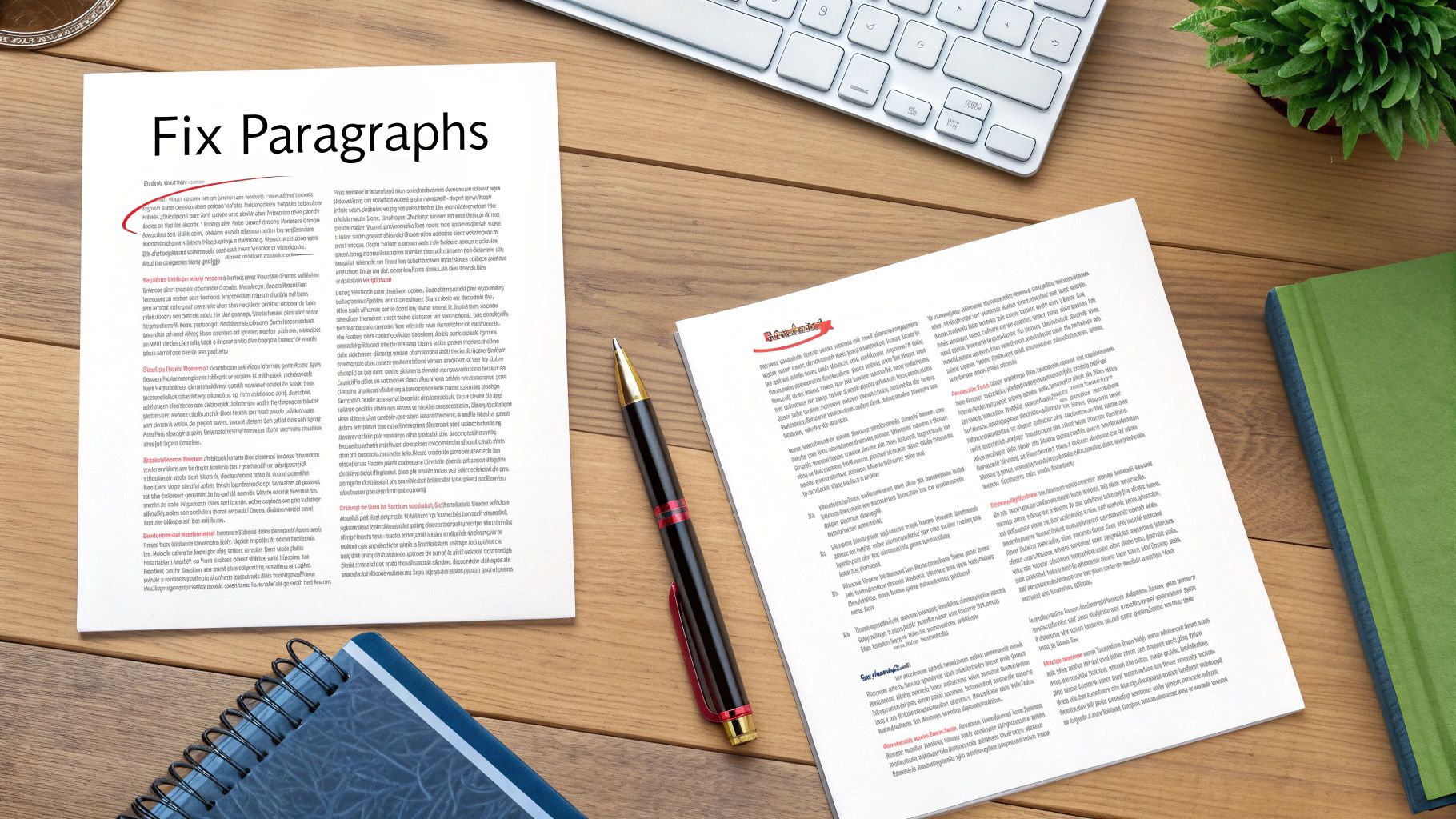
Even the most seasoned writers fall into bad habits. The good news? Once you can spot the common paragraphing pitfalls in your own work, you gain the power to fix them with surgical precision.
Most paragraph errors boil down to just a few usual suspects. Let's walk through the three most frequent offenders and the surprisingly simple ways to set them right.
The Headless Paragraph
You've seen this one before. It’s a paragraph that dives straight into details, quotes, or examples without first telling you what it’s all about. It has no topic sentence, leaving the reader to guess the point of it all.
- The Problem: The sentences feel like a random list of facts because there's nothing holding them together. Your reader is lost from the start.
- The Fix: Just read the paragraph and ask yourself, "What's the one big idea I'm trying to get across here?" Turn that answer into a clear, direct sentence and stick it right at the beginning.
The Overstuffed Paragraph
This is a classic mistake: trying to cram too many ideas into one little paragraph. The focus jumps from one point to the next, creating a chaotic mess that tanks your credibility.
Key Takeaway: A paragraph should have one job. Just one. Its only purpose is to explore a single, unified idea. The moment you introduce a second major point, it's time for a new paragraph.
To fix an overstuffed paragraph, hunt down each distinct idea. Pull them apart and give each one its own focused paragraph, complete with its own topic sentence. This one change makes your writing infinitely easier to follow.
The Wandering Paragraph
A wandering paragraph might start off strong with a solid topic sentence, but then its supporting sentences start to drift. It includes bits of information that are only vaguely related—or completely irrelevant—to the main point, which completely torpedoes the argument.
Think of it like telling a story and suddenly throwing in a random detail about what you ate for lunch yesterday. It just breaks the flow.
To get this paragraph back on track, try a reverse outline. Go through the paragraph sentence by sentence and jot down the main point of each one. If a sentence doesn't directly back up your topic sentence, it either needs a rewrite to make it relevant or it needs to go. Every single sentence must serve the paragraph’s main goal.
Got Questions About Paragraphs? We've Got Answers.
Even after you've got the basics down, a few nagging questions always seem to pop up once you start putting pen to paper (or fingers to keyboard). This is where we clear up the common sticking points.
Think of this as your go-to FAQ for all things paragraph structure.
How Long Should a Paragraph Be?
There’s no magic word count. The right length depends entirely on where your writing will live and what you’re trying to achieve.
- In academic writing, you'll often see paragraphs between 100 and 250 words—usually five to eight sentences. That's enough space to really unpack a complex idea with the depth it deserves.
- For online content, shorter is almost always better. Think two to four sentences. Whether it’s a blog post or an email, snappy paragraphs keep readers scrolling and make your content much easier to digest on a screen.
You can even throw in a single-sentence paragraph for a little drama or to make a key point land with a punch. The real rule is simple: a paragraph should be just long enough to explore one main idea. No more, no less.
Can a Paragraph Have More Than One Main Idea?
That’s a hard no. If you take away only one thing, let it be this: one paragraph, one idea. This is the golden rule of clear writing. Each paragraph needs to be a self-contained little package of thought, neatly introduced by its topic sentence.
The moment you start trying to jam multiple ideas into one paragraph, you muddy the waters and your argument falls apart. If you feel your thoughts starting to drift toward a new topic, that’s your cue. It’s time to hit "Enter" and start fresh.
Remember This: The second you introduce a new major point, you need a new paragraph. Mastering this one little habit will instantly make your writing feel more organized and professional.
What’s the Difference Between a Concluding and a Transition Sentence?
Both of these show up at the end of a paragraph, but they do slightly different jobs. Knowing when to use each one gives you more control over your reader's journey.
A concluding sentence is all about closure. It wraps up the main point of the paragraph, tying everything off with a neat bow. It's the perfect way to end the final paragraph of an essay or a standalone section where you don't need to lead anywhere else.
A transition sentence is a bit more ambitious. It gives a quick nod to the idea you just discussed, then builds a bridge to the point you’re about to make in the next paragraph. This creates that smooth, connected flow that makes a piece of writing so satisfying to read. For most body paragraphs, this is the one you want.
How Does Paragraph Structure Affect SEO?
While paragraph structure isn't a direct ranking factor, its impact on Search Engine Optimization (SEO) is huge. Why? Because Google cares about user experience, and good structure is all about making the reader happy.
Well-structured paragraphs—with short sentences, clear topic sentences, and plenty of white space—are just plain easier to read. This encourages people to stick around, which increases your "dwell time" and lowers your "bounce rate."
When search engines see those positive signals, they take it as a sign that your content is valuable, and that can help you climb the rankings. Plus, breaking up your text with clear headings helps Google’s crawlers figure out what your page is about, giving your SEO another nice little boost.
Turning robotic AI drafts into writing that feels human can be a real grind. Natural Write instantly refines your text, making it flow perfectly and sound completely natural, so you can bypass AI detection. Polish your paragraphs with one click at https://naturalwrite.com.
